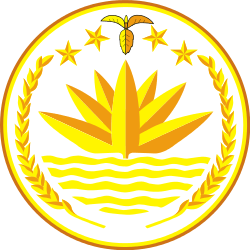Malto people
The Malto or Maler people, also known as Pahariya, are a Dravidian tribal group from the Rajmahal Hills in the northeastern Chota Nagpur Plateau. They are divided into three subgroups: Mal Paharia, Sauria Paharia and Kumarbhag Paharia.[1] All three are listed as Scheduled Tribes in Jharkhand, Bihar and West Bengal. They speak the Malto language, related to the nearby Kurukh language.
When the British first encountered them they were nomadic. They practiced jhum cultivation, as well as hunting and gathering, and would often also raid the plains of Bihar to the north or Bengal to the east, and would then retreat back into the forest. If there was a crop failure, death or other disaster, they would move to a new spot. Due to the remoteness of their territory they were never conquered by any of the many empires that claimed to rule the region. When the British induced Santals to cultivate the Rajmahal Hills, the Maltos fought back, but were eventually driven out.[2]
The Mal Paharia and Kumarbhag Paharia subgroups combined have a population of 182,560, while the Sauria Paharia subgroup has a population of 51,634, making the total Malto population 234,194.[3]
Today they still practice jhum cultivation, and collect minor forest produce. They are plagued by many problems, including high levels of poverty and extreme malnutrition. For this reason they are classified as a Particularly Vulnerable Tribal Group. However some are now settled cultivators.[4]
Among the Sauria Paharia, their traditional marriage ceremony is known as bedi, that takes place in a house. Their society has no restrictions on premarital sexual relations, and children not born out of a marriage can still live with the mother. Another type of common marriage is marriage by capture.[4] The main Malto god is Dharmer Gosain, a sun god, while their priests are known as demano.[2]
The men wear a small loincloth, known as bhagwan, while the women wear two garments: panchi, an upper garment, usually an unstitched cloth, and pardhan, a cloth around the waist.[4]
See also
References
- "Definition: malto". Dictionary.die.net. Archived from the original on 2012-07-09. Retrieved 2008-08-06.
- Crooke, William, 1848-1923. (1973). Races of northern India. Cosmo Publications. ISBN 0-336-00404-4. OCLC 805760.CS1 maint: multiple names: authors list (link)
- "A-11 Individual Scheduled Tribe Primary Census Abstract Data and its Appendix". www.censusindia.gov.in. Office of the Registrar General & Census Commissioner, India. Retrieved 2017-11-03.
- Ghosh, Anita. "Souria Paharia are now in Transition: Beliefs, Rituals and Practices" (PDF). ResearchGate.
